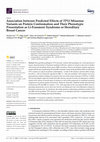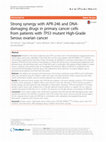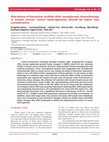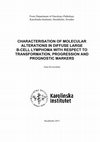Papers by Svetlana Lagercrantz

ESTROGENS are steroid hormones that have profound effects on both the female and the male reprodu... more ESTROGENS are steroid hormones that have profound effects on both the female and the male reproductive systems. They also have important roles in the cardiovascular system and in maintenance of bone tissue. These effects are all mediated by a ligand-activated transcription factor, the estrogen receptor (ER). Our unexpected discovery of a second subtype of the estrogen receptor, ER�, approximately 10 yr after the cloning of ER� (1) has raised a number of questions regarding the respective physiological roles of these two receptors (2). Some of the most interesting aspects of the new estrogen receptor refer to clinically important issues such as fertility, bone stability, and cardiovascular health. It has previously been assumed that ER�, the first estrogen receptor to be cloned, was indispensable for maintenance of these functions. However, studies of ER � knock-out (ERKO) mice show that the gene deletion has little or no effect on bone stability or on the cardiovascular system (3). ...

International Journal of Molecular Sciences, 2021
Rare germline pathogenic TP53 missense variants often predispose to a wide spectrum of tumors cha... more Rare germline pathogenic TP53 missense variants often predispose to a wide spectrum of tumors characterized by Li-Fraumeni syndrome (LFS) but a subset of variants is also seen in families with exclusively hereditary breast cancer (HBC) outcomes. We have developed a logistic regression model with the aim of predicting LFS and HBC outcomes, based on the predicted effects of individual TP53 variants on aspects of protein conformation. A total of 48 missense variants either unique for LFS (n = 24) or exclusively reported in HBC (n = 24) were included. LFS-variants were over-represented in residues tending to be buried in the core of the tertiary structure of TP53 (p = 0.0014). The favored logistic regression model describes disease outcome in terms of explanatory variables related to the surface or buried status of residues as well as their propensity to contribute to protein compactness or protein-protein interactions. Reduced, internally validated models discriminated well between LFS...

International journal of oncology, 2004
In this study seven primary kidney tumors out of 13 were cytogenetically characterized by compara... more In this study seven primary kidney tumors out of 13 were cytogenetically characterized by comparative genomic hybridization (CGH) on the surgical specimens as well as by spectral karyotyping (SKY) analysis after short-term culturing. In two of the seven cases only a normal karyotype was identified. Non-clonal aberrations were observed in four of the seven cases. Overall numerical alterations were more frequent than structural changes. The two structural alterations identified constituted of a deletion of the short arm of chromosome 3 in a conventional renal cell carcinoma (RCC), and a ring chromosome derived from chromosome 8 in a papillary RCC. By CGH gains of copy number were revealed on chromosomes 3, 5, 7, 8q, and 20, while the losses encompassed 3p and 17p. In the papillary RCCs only gains were found. Comparison between SKY and CGH data suggests that the conventional RCCs are genetically more homogeneous than the other types of kidney cancer. In the two papillary RCCs, trisomie...

European Journal of Medical Genetics, 2021
Hereditary breast and ovarian cancer (HBOC) is a syndrome defined by an increased risk of develop... more Hereditary breast and ovarian cancer (HBOC) is a syndrome defined by an increased risk of developing breast and/or ovarian cancer most commonly due to germline disease-causing variants in the BRCA1 and BRCA2 genes, but also other causative genes such as PALB2, ATM and CHEK2. As genetic testing becomes more prevalent and new clinical data emerge, updates of national guidelines are required to incorporate these advances in our knowledge. The aim of this work is to review the guidelines for HBOC genetic testing and clinical surveillance across European countries, mostly affiliated to the European Reference Network (ERN) for Genetic Tumor Risk Syndroms (GENTURIS). Young onset breast cancer (BC), triple negative phenotype, or bilateral BC are considered as criteria for genetic testing in all, with differences in age limits. Testing of invasive epithelial non-mucinous ovarian cancer is also universally accepted. While breast magnetic resonance imaging (MRI) is consistently recommended in high-risk individuals, age of onset for mammograms differ between 30 and 40 years. Risk-reducing mastectomy is commonly offered as an option, while risk-reducing salpingo-oophorectomy is universally recommended. The largest differences are observed with respect to ovarian surveillance prior to risk-reducing salpingo-oophorectomy and in breast surveillance for carriers of non-BRCA1/2 genes. These differences in national guidelines reflect the variations in clinical consensus that may be reached in the absence of consistent evidence for some recommendations.

Pathobiology, 2018
Objective: The aim of this study was to identify differences in proteome profiles of diffuse larg... more Objective: The aim of this study was to identify differences in proteome profiles of diffuse large B-cell lymphoma (DLBCL) of nongerminal center (non-GC) versus GC type in the search for new markers and drug targets. Methods: Six DLBCL, with 3 repeats for each, were used for the initial study by proteomics: 3 non-GC and 3 GC DLBCL cases. For immunohistochemistry, tissue microarrays were made from 31 DLBCL samples: 16 non-GC de novo lymphomas and 15 GC cases (11 transformed from follicular lymphomas and 4 de novo GC lymphomas). Proteome profiling was performed by two-dimensional gel electrophoresis and MALDI-TOF mass spectrometry. Results: Ninety-one proteins were found differentially expressed in non-GC compared to GC type. The Cytoscape tool was used for systemic analysis of proteomics data, revealing 19 subnetworks representing functions affected in non-GC versus GC types of DLBCL. Conclusion: A validation study of 3 selected proteins (BiP/Grp78, Hsp90, and cyclin B2) showed the e...

International journal of cancer, Jan 2, 2018
Breast cancer patients with BRCA1/2-driven tumors may benefit from targeted therapy. It is not cl... more Breast cancer patients with BRCA1/2-driven tumors may benefit from targeted therapy. It is not clear whether current BRCA screening guidelines are effective at identifying these patients. The purpose of this study was to evaluate the prevalence of inherited BRCA1/2 pathogenic variants in a large, clinically representative breast cancer cohort and to estimate the proportion of BRCA1/2 carriers not detected by selectively screening individuals with the highest probability of being carriers according to current clinical guidelines. The study included 5,122 unselected Swedish breast cancer patients diagnosed from 2001 to 2008. Target sequence enrichment (48.48 Fluidigm Access Arrays) and sequencing were performed (Illumina Hi-Seq 2500 instrument, v4 chemistry). Differences in patient and tumor characteristics of BRCA1/2 carriers who were already identified as part of clinical BRCA1/2 testing routines and additional BRCA1/2 carriers found by sequencing the entire study population were co...

Journal of Ovarian Research, 2016
Background: Mutation in the tumor suppressor gene TP53 is an early event in the development of hi... more Background: Mutation in the tumor suppressor gene TP53 is an early event in the development of high-grade serous (HGS) ovarian cancer and is identified in more than 96 % of HGS cancer patients. APR-246 (PRIMA-1 MET) is the first clinical-stage compound that reactivates mutant p53 protein by refolding it to wild type conformation, thus inducing apoptosis. APR-246 has been tested as monotherapy in a Phase I/IIa clinical study in hematological malignancies and prostate cancer with promising results, and a Phase Ib/II study in combination with platinum-based therapy in ovarian cancer is ongoing. In the present study, we investigated the anticancer effects of APR-246 in combination with conventional chemotherapy in primary cancer cells isolated from ascitic fluid from 10 ovarian, fallopian tube, or peritoneal cancer patients, 8 of which had HGS cancer. Methods: Cell viability was assessed with fluorometric microculture cytotoxicity assay (FMCA) and Combination Index was calculated using the Additive model. p53 status was determined by Sanger sequencing and single strand conformation analysis, and p53 protein expression by western blotting. Results: We observed strong synergy with APR-246 and cisplatin in all tumor samples carrying a TP53 missense mutation, while synergistic or additive effects were found in cells with wild type or TP53 nonsense mutations. Strong synergy was also observed with carboplatin or doxorubicin. Moreover, APR-246 sensitized TP53 mutant primary ovarian cancer cells, isolated from a clinically platinum-resistant patient, to cisplatin; the IC 50 value of cisplatin decreased 3.6 fold from 6.5 to 1.8 μM in the presence of clinically relevant concentration of APR-246. Conclusion: These results suggest that combination treatment with APR-246 and DNA-damaging drugs could significantly improve the treatment of patients with TP53 mutant HGS cancer, and thus provide strong support for the ongoing clinical study with APR-246 in combination with carboplatin and pegylated liposomal doxorubicin in patients with recurrent HGS cancer.

International Journal of Molecular Medicine, 2000
Chromosomal rearrangements in short term cultures from nine cases of non-Hodgkin&... more Chromosomal rearrangements in short term cultures from nine cases of non-Hodgkin's lymphomas (NHL) were characterized by G-banding, spectral karyotyping (SKY), and fluorescence in situ hybridization (FISH). Eight of the nine cases showed complex karyotypes with chromosomal aberrations which, in most cases, could not be fully characterized by traditional G-banding analysis alone. Karyotypic abnormalities of special interest were marker chromosomes and chromosomes with added unidentified chromosomal material, as previously non-identified chromosomal translocations were hidden behind these aberrations. SKY and FISH analysis, as a complement to banding analysis, significantly improved the karyotypes in seven of the nine cases and unveiled 21 previously unidentified rearrangements with novel translocation breakpoints. Traditional G-banding alone revealed seven new rearrangements, which were all confirmed by SKY. None of these new aberrations occurred as single clonal rearrangements but as parts of complex karyotypes. Nevertheless, the chromosomal break-point regions identified should be considered as potential hot spots for genes involved in the tumorigenesis of the malignancy.

Fluorescence in situ hybridization (FISH) has been shown to be a valuable andimportant technique ... more Fluorescence in situ hybridization (FISH) has been shown to be a valuable andimportant technique in cytogenetics, as a complement to traditional bandinganalysis. This thesis focus on the characterization of chromosomalrearrangements in two hematological neoplasias, myelodysplastic syndrome(MDS) and non-Hodgkin lymphoma (NHL) using FISH.The increased cytogenetic resolution obtained by FISH, made it possible toidentify a true-whole arm translocation consisting of 17q and 18q, in a case ofMDS. The derivative chromosome had a centromere with sequences from bothchromosomes 17 and 18. Thus, a breakpoint on either of the p-arms could beexcluded, and it could be concluded that the rearrangment resulted inmonosomy of 17p and 18p without affecting expressed genes located in thecentromeric region.Chromosome painting, FISH with chromosome specific libraries, on short termcultures of NHL showed that chromosomal rearrangements were often morecomplex than the banding analysis predicted. Painting analysis couldcontribute with new information, not only of translocations, but also of truedeletions and amplification. This could significantly clearify the true karyotypeof the malignant cell.A recurring rearrangement in NHL is additional material on the tip of the shortarm of chromosome 1. Using chromosome specific libraries it was possible toshow that, in three out of nine such cases, the extra chromosomal materialoriginated from the long arm of chromosome 2, resulting in a der(1)t(1;2). Thethree cases were all follicular NHL, although non of them had the t(14;18)found in 85-90% of follicular lymphomas. In addition, one of the cases, had theder(1)t(1;2) as the only rearrangement in one of two malignant clones. All threecases had the der(1)t(1;2) in addition to two normal chromosome 2 homologs,leading to a duplication of 2q31-qter. These findings exemplifies that newcytogenetic subgroups can be identified when banding analysis iscomplemented with chromosome painting.Furthermore, we found a case of NHL with a der(22)t(2;22) as a sole aberration.This results in a cytogenetically identical duplication of 2q31-qter, as in thecases with der(1)t(1;2). These findings suggest that cancer relevant genes maybe located at the distal 2q.LAZ3/BCL6 gene has been implicated in tumorigenesis of NHL. Therefore theexpression pattern of the LAZ3/BCL6 gene was studied, using RNA in situhybridization. It was shown that LAZ3/BCL6 is expressed in follicular center(FC) B-cells of both non malignant reactive lymph nodes and FC-derived non-Hodgkin lymphomas. Furthermore, LAZ3/BCL6 is expressed in a number ofdifferent tissues such as skeletal muscle, spinal cord, trachea, and peripheralblood leukocytes. The data clearly show that the expression of the LAZ3/BCL6is not confined to the malignant cells, and thus its role in the malignanttransformation must be reconsidered.Key words: Myelodysplastic syndrome, non-Hodgkin lymphoma, fluorescencein situ hybridization, LAZ3/BCL6 expression, chromosome rearrangementsISBN 91-628-1994-1 Stockholm, 199

Oncotarget, Jan 5, 2015
Tumor biomarkers including estrogen receptor (ER), progesterone receptor (PR), human epidermal gr... more Tumor biomarkers including estrogen receptor (ER), progesterone receptor (PR), human epidermal growth factor receptor 2 (HER2) and Ki-67 are routinely tested in breast cancer patients and their status guides clinical management and predicts prognosis. A few retrospective studies have suggested that neoadjuvant chemotherapy (NAC) in breast cancer may change the status of biomarker expression, which in turn will affect further management of these patients. In this study we take advantage of a relatively large cohort and aim to study the effect of NAC on biomarker expression and explore the impact of tumor size and lymph node involvement on biomarker status changes. We collected 107 patients with invasive breast cancer who received at least three cycles of NAC. We retrospectively performed and scored the immunohistochemistry (IHC) of ER, PR, HER2 and Ki-67 using both the diagnostic core biopsies before NAC and excisional specimens following NAC. HER2 gene status was assessed by fluores...

Cancer Research, 2015
Background: Mutations in the TP53 gene occur in at least 60% of ovarian tumors and are associated... more Background: Mutations in the TP53 gene occur in at least 60% of ovarian tumors and are associated with chemoresistance and poor prognosis. APR-246 (PRIMA-1MET) is the first mutant p53-reactivating compound in clinical development and has been tested as monotherapy in hematological malignancies and prostate cancer with promising results (Lehmann et al. J Clin Oncol 30, 2012). The aim of this study was to investigate the anticancer effects of APR-246 in combination with conventional chemotherapy in cancer cells isolated from ascites fluid from ovarian cancer patients. Methods: Ascites cells were purified by Ficoll and viably frozen, and the quality and purity were confirmed by May Grünwald/Giemsa staining. For some samples, immunocytochemical stainings with anti-Ber-EP4 and anti-calretinin antibodies were used to distinguish between mesothelial and cancer cells. Cell viability was assessed with FMCA assay and Combination Index (CI) calculated using Additive model. CI < 0.8 indicate...

Annals of Diagnostic Pathology, 2015
Immunohistochemical analysis of proliferation markers such as Ki-67 and cyclin A is widely used i... more Immunohistochemical analysis of proliferation markers such as Ki-67 and cyclin A is widely used in clinical evaluation as a prognostic factor in breast cancer. The proliferation status of tumors is guiding the decision of whether or not a patient should be treated with chemotherapy because low-proliferative tumors are less sensitive by such treatment. However, the lack of optimal cutoff points and selection of tumor areas hamper its use in clinical practice. This study was performed to compare the Ki-67 and cyclin A expression counted in hot-spot vs average counting based on 5 to 14 random tumor areas in 613 breast carcinomas. We correlated the findings with 10-year follow-up in order to standardize the evaluation of proliferation markers in clinical practice. A significant correlation was found between the percentage of positive cells estimated by Ki-67 and cyclin A both by hot-spot and by average counting. Both methods showed that high expression of Ki-67 and cyclin A is associated with more adverse tumor stage. The cutoff value for Ki-67 for distant metastases was set to 22% and to 15%, using hot-spot and average counting, respectively. For cyclin A, the values were set to 14% and 8% using the respective methods. Survival curves revealed that patients with a high hot-spot proliferation index had a significantly greater risk of shorter tumor-free survival. Our findings suggest that the determination of proliferation markers in breast cancer should be standardized to hot-spot counting and that specific cutoff values for proliferation could be useful as prognostic markers in clinical practice. Moreover, we suggest that expression levels of cyclin A could be used as a complementary marker to estimate the proliferation status in tumors, especially those with &amp;amp;amp;amp;amp;amp;amp;amp;amp;amp;amp;amp;amp;amp;amp;amp;amp;amp;amp;amp;amp;amp;amp;amp;amp;amp;amp;amp;amp;amp;amp;amp;amp;amp;amp;amp;amp;amp;amp;amp;amp;amp;amp;amp;amp;amp;amp;amp;amp;amp;amp;amp;amp;amp;amp;amp;amp;amp;amp;amp;amp;amp;amp;amp;amp;amp;amp;amp;amp;amp;amp;amp;amp;amp;amp;amp;amp;amp;amp;amp;amp;amp;amp;amp;amp;amp;amp;amp;amp;amp;amp;amp;amp;amp;amp;amp;amp;amp;amp;amp;amp;amp;amp;amp;amp;amp;amp;amp;amp;amp;amp;amp;amp;amp;amp;amp;amp;amp;amp;amp;amp;amp;amp;amp;amp;amp;amp;amp;amp;amp;amp;amp;amp;amp;amp;amp;amp;amp;amp;amp;amp;amp;amp;amp;amp;amp;amp;amp;amp;amp;amp;amp;amp;amp;amp;amp;amp;amp;quot;borderline&amp;amp;amp;amp;amp;amp;amp;amp;amp;amp;amp;amp;amp;amp;amp;amp;amp;amp;amp;amp;amp;amp;amp;amp;amp;amp;amp;amp;amp;amp;amp;amp;amp;amp;amp;amp;amp;amp;amp;amp;amp;amp;amp;amp;amp;amp;amp;amp;amp;amp;amp;amp;amp;amp;amp;amp;amp;amp;amp;amp;amp;amp;amp;amp;amp;amp;amp;amp;amp;amp;amp;amp;amp;amp;amp;amp;amp;amp;amp;amp;amp;amp;amp;amp;amp;amp;amp;amp;amp;amp;amp;amp;amp;amp;amp;amp;amp;amp;amp;amp;amp;amp;amp;amp;amp;amp;amp;amp;amp;amp;amp;amp;amp;amp;amp;amp;amp;amp;amp;amp;amp;amp;amp;amp;amp;amp;amp;amp;amp;amp;amp;amp;amp;amp;amp;amp;amp;amp;amp;amp;amp;amp;amp;amp;amp;amp;amp;amp;amp;amp;amp;amp;amp;amp;amp;amp;amp;amp;quot; expression levels of Ki-67, in order to more accurately estimate the proliferations status of the tumors.

International Journal of Molecular Medicine, 2001
The multiple endocrine neoplasia type 1 gene (MEN1) is a tumor suppressor gene associated with th... more The multiple endocrine neoplasia type 1 gene (MEN1) is a tumor suppressor gene associated with the development of tumors in the parathyroids, the pituitary, and the pancreas and has also been linked to impaired germ cell production. The murine ortholog, Menl, is highly homologous to the human counterpart both at DNA and protein levels. The present study was undertaken to further approach the function of Menl and its encoded protein menin. By 5' RACE and RT-PCR four alternative splice variants were identified, indicating a 5' heterogeneity of Menl similar to the human counterpart. By mRNA in situ hybridization of embryonal and adult mouse tissues, all four splice variants were shown to be expressed, albeit at varying timepoints and levels in the different tissues. However, a putative isoform postulated from the DNA sequence, which would elongate the reading frame by 15 bases at the exon 2/intron 2 junction, was not found to occur in mouse. The strongest expression was detected in testis, both at the mRNA and protein level and was therefore further characterized by protein analysis of cells isolated from different stages of the spermatogenesis. Western blotting revealed a single protein of approximately 70 kDa detected in total testis, isolated pachytene spermatocytes and in haploid spermatids. Notably, no menin expression was detectable in the extracts from epididymis where the maturation of sperms is almost completed, suggesting that menin plays a crucial role during spermatogenesis.

Genes Chromosomes Cancer, 2014
Diffuse large B-cell lymphoma (DLBCL) is the most common lymphoma type, and comprises nearly 500 ... more Diffuse large B-cell lymphoma (DLBCL) is the most common lymphoma type, and comprises nearly 500 newly diagnosed cases in Sweden every year. DLBCL is a group of aggressive lymphomas that are extremely heterogeneous and differ in morphology, immunophenotype, molecular and clinical features as well as in response to therapy. The transformation of low malignant lymphoma, most commonly follicular lymphoma (FL), to DLBCL is associated with a progressive disease and poor prognosis. The overall aim of this thesis was to identify the genetic events underlying the progression and transformation of indolent FL to aggressive DLBCL and to outline molecular alterations distinguishing DLBCL with germinal center (GC) and non-GC phenotype. In search for novel markers in lymphoma, we have investigated an anti-apoptotic protein, HS-associated protein X-1 (HAX-1), at the protein and transcript level in malignant lymphomas (paper I). We found high levels of HAX-1 mRNA and protein expression in Bcell lymphomas. We also identified a positive association between proliferation (Ki67) and HAX-1 expression, as well as an inverse correlation between Bcl-2 and HAX-1 demonstrated on a transcript and protein level in FL, which indicates the potential role of HAX-1 as a Bcl-2 homolog. In papers II and III we studied paired tumours of FL and its transformed DLBCL (tDLBCL) counterparts and compared with de novo DLBCL (dnDLBCL) using arraycomparative genome hybridisation (array-CGH) in order to outline genetic alteration of importance for the transformation process. We identified a gain of 2p15-16.1 as a potential prognostic marker, and that this alteration may appear already in the FL prior to transformation. This chromosomal region encompasses, among others, genes involved in NF-κB pathway, such as REL, USP34, COMMD1, OTX1 and of known importance for B-cell development, such as BCL11A. We have also performed whole exome sequencing (WES) results in a smaller group of patients with consecutive lymphoma samples. A comparison with array-CGH data showed that these two methods complement and strengthen each other in pinpointing crucial genetic events. Furthermore, our studies revealed that clonal evolution of transformed tumours occurs according to the branching model. A number of mutations identified in the peri-transformation phases-defined as FL appearing prior and tDLBCL directly after transformation-affected genes involved in histone modifications, cell cycle, apoptosis, PI-3 kinase pathway, and Ras signalling pathway. In Paper IV we performed proteomic profiling of DLBCL subtypes i.e. non-GC and GC, and identified 91 proteins present exclusively in the non-GC type of DLBCL. We focused on two proteins of importance for the NF-κB pathway (BiP and Hsp90) as well as on Cyclin B2. We observed increased expression of these three proteins in DLBCL and also in non-GC vs GC type of DLBCL. These findings suggest a potential relevance of these proteins as prognostic markers and may lead to new treatment options.

International Journal of Oncology, 2002
The frequent and generalized chromosomal imbalances that are characteristic of adrenocortical car... more The frequent and generalized chromosomal imbalances that are characteristic of adrenocortical carcinomas suggest that incomplete chromosome segregation often takes place in these tumors. As a step towards elucidating the mechanism behind the multiple numerical chromosomal aberrations, we have evaluated a series of 14 such tumors for centrosome abnormalities using immunohistochemical detection of the gamma-tubulin centrosome component. The proportion of cells with more than the expected number of 2 centrosomes was moderately increased in the 4 adenomas (1-7%), while a high increase was observed in the 10 carcinomas (1-19%), as compared to the normal reference tissues (0.3%) (p&amp;amp;amp;amp;amp;amp;amp;amp;amp;amp;amp;amp;amp;amp;amp;amp;amp;amp;amp;amp;amp;amp;amp;amp;amp;amp;amp;amp;amp;amp;amp;amp;amp;amp;amp;amp;lt;0.001). Similarly, the centrosome amplification tended to be more pronounced in the carcinomas where the aberrant cells carried 3 or 4 positive signals in 9 of the 10 tumors, and 6 signals were recorded in one tumor, while in the adenomas more than 3 signals was only recorded in one of the 4 cases. The findings demonstrate that centrosome amplifications occur frequently in both adrenocortical adenomas and carcinomas, thus supporting its role in driving the tumor development as opposed to being a consequence of it. Furthermore, the more pronounced occurrence in the malignant form as well as in the larger tumors, offers one likely explanation for the increasing generalized aneuploidy observed during the tumor development, and points to new therapeutic strategies aimed at restoring normal centrosome function.
Leukemia & Lymphoma, 2007
Department of Oncology, Radiology and Clinical Immunology, Uppsala University, Uppsala University... more Department of Oncology, Radiology and Clinical Immunology, Uppsala University, Uppsala University Hospital, Uppsala, Sweden, Department of Tumor Biology, Lund University, Malmö University Hospital, Malmö, Sweden, Health and Society, Biomedical Laboratory Science, Malmö University, Malmö, Sweden, Laboratory Medicine, Malmö University Hospital, Malmö, Sweden, Department of Medical Sciences, Division of Clinical Pharmacology, Department of Genetics and Pathology, Uppsala University, Uppsala University Hospital, Uppsala, Sweden, Department of Molecular Medicine and Surgery, CMM L8:01, Karolinska Institutet and University Hospital, Stockholm, Sweden, and Department of Clinical Genetics, University Hospital, Lund, Sweden

Leukemia & Lymphoma, 2008
The study was undertaken with the aim to outline deletion patterns involving the long arm of chro... more The study was undertaken with the aim to outline deletion patterns involving the long arm of chromosome 6, a common abnormality in lymphoproliferative disorders. Using a chromosome 6 specific tile path array, 60 samples from in total 49 cases with mantle cell lymphoma (MCL), de novo diffuse large B-cell lymphoma (DLBCL), transformed DLBCL as well as preceding follicular lymphoma (FL), and childhood acute lymphoblastic leukemia (ALL), were characterized. Twenty-six of the studied cases, representing all diagnoses, showed a 6q deletion among which 85% involved a 3 Mb region in 6q21. The minimal deleted interval in 6q21 encompasses the FOXO3A, PRDM1 and HACE1 candidate genes. The PRDM1 gene was found homozygously deleted in a case of DLBCL. Moreover, in two DLBCL cases, an overlapping homozygous deletion was identified in 6q23.3 - 24.1, encompassing the TNFAIP3 gene among others. Taken together, we refined the deletion pattern within the long arm of chromosome 6 in four different types of hematological malignances, suggesting the location of tumor suppressor genes involved in the tumor progression.

Leukemia, 1997
Chromosomal translocation resulting in abnormal expression Thus the expression is not confined to... more Chromosomal translocation resulting in abnormal expression Thus the expression is not confined to malignant B cells but of the LAZ3/BCL6 gene in B cells has been implicated in the reflects the origin of B cells from the germinal centers. tumorigenesis of non-Hodgkin lymphoma (NHL). Therefore we studied the expression pattern of LAZ3/BCL6 by in situ hybridization with synthetic oligonucleotide probes in frozen tissue sections from five reactive lymph nodes and 38 B cell and non-B NHL. In addition, we investigated the expression of Materials and methods LAZ3/BCL6 by Northern blot analysis on multiple human tissues. The LAZ3/BCL6 transcript was found in a variety of tissues, including skeletal muscle, peripheral blood leukocytes, and weakly in normal lymph nodes. In the tumor samples, Tissue samples expression of LAZ3/BCL6 was observed in 68% of all B cell NHL and none of the non-B lymphomas. All cases of follicular, Lymph node biopsies were taken for diagnostic purposes from mixed small and large cell lymphomas showed LAZ3/BCL6 42 patients with NHL or reactive hyperplasia. Representative expression confined to the neoplastic follicles. A follicular samples were frozen in liquid nitrogen and stored in −70°C. expression pattern was also found in all non-malignant reactive lymph nodes. Hence, the expression of LAZ3/BCL6 does not B5-or formalin-fixed samples were embedded in paraffin and correlate to malignancy, but reflects the origin of B cells from stained with hematoxylin and eosin, Giemsa and PAS stains. the germinal centers. Gordon-Sweet staining was used to determine the growth pat-Keywords: non-Hodgkin lymphoma; LAZ3/BCL6 expression; RNA tern. NHL were classified according to the revised Europeanin situ hybridization American classification 9 and the updated Kiel classification. 10 Immunophenotyping was performed by routine immunohistochemistry on frozen or paraffin sections, and/or flow cytometry on cell suspensions. In follicle center cell (FCC)-derived










Uploads
Papers by Svetlana Lagercrantz